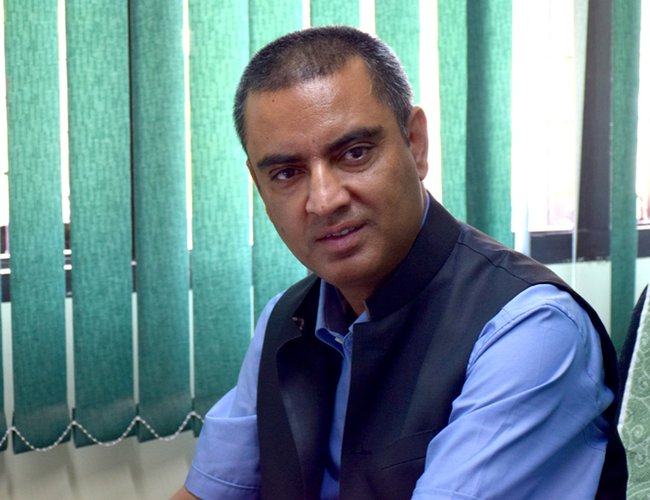
What are the trends in climate finance in Nepal?
Nepal is one of the most vulnerable countries to climate change. Climate-induced extreme events like floods, landslides, droughts have become more frequent resulting in the loss of human as well as physical properties. Nepal's economy is dependent on agriculture, which contributes to 30% of the national GDP. The agriculture sector is directly affected by the climate change impact and the production is getting down. Due to climate change effect, Nepal is bearing an annual loss of about 1.5% to 2% of its GDP, which will increase in the future.
The Government of Nepal has started to allocate budget under the climate finance category in the national budget, however, of the direct relevance to climate change is the 5.90 percent of the total budget allocated in fiscal year 2016/17.
In Nepal, climate adaptation and mitigation projects are implemented through different financial mechanisms- through government's fund flow mechanism and through various institutions, NGO s and INGOs. One of the projects implemented through government's fund flow system is the NCCSP project implemented by the Ministry of Population and Environment, which is the pioneer project that translates the Climate Change Policy's provision to spending 80 % of climate finance at the local level.
Nepal has already prepared Low Carbon Economic Development Strategy (LCEDS), which is in the endorsement process, and this encourages environmentally sustainable development. Nepal's Nationally Determined Contributions (NDC) further presents Nepal's commitments towards climate change adaptation and low carbon development. Similarly, Nepal is preparing National Adaption Plan (NAP) to address mid and long term adaptation issues. However, the implementation of this important plan will largely depend on foreign financial and technical support.
Where does climate finance come from in Nepal?
Nepal accesses various international climate funds-multilateral and bilateral public sources. Nepal received financial support from the multilateral funding sources like CIF, SREP, LDCF and the Forest Fund. The Pilot Program for Climate Resilience (PPCR) was implemented in Nepal in support of the CIF. Similarly, Nepal Climate Change Support Program (NCCSP), Ecosystem Based Adaption are being implemented through bilateral support. The UK Government's DFID and EU provided £17.6 million to implement 100 LAPAs in 14 districts of the far and mid-western region through NCCSP.
As a Least Developed Country, Nepal also accesses finance from international funds established under the United Nations Framework Convention on Climate Change (UNFCCC). Recently the Adaptation Fund Board agreed to provide financial support of US$ 29 million to Nepal through WFP as an MIE to implement Adaptation to climate-induced threats to food production and food security in the Karnali region of Nepal. Likewise, the MoPE is going to get the support of 2.9 million US $ from GCF to facilitate National Adaptation Plan formulation process. Nepal has utilized funds from LDCF through UNDP, UNEP, and FAO for GLOF and Agriculture related projects. Not only climate change adaptation, several initiatives on climate change mitigation were undertaken by Nepal. The CDM, REDD are some of the projects of this category.
The government of Nepal has itself allocated certain climate change related budget from its national budget. In the FY 2016/17, the GoN allocated 19.22 percent of the national budget for climate change related activities (both direct and indirect) through various ministries.
What institutions in Nepal facilitate international climate finance into Nepal?
The Ministry of Population and Environment has established Climate Change Finance Management Section to effectively access and mobilize financial resources to confront climate change issues in Nepal. The MoPE supported the Agriculture Development Bank Limited to lodge the application of NIE accreditation, which is an initial step to harness climate finance from AF for climate change adaptation. Similarly, there are other international sources such as GCF, LDCF, SCCF that Nepal is eligible to access. However, our institutions should be strengthened with a dedicated structure and capable human resources to understand the process and facilitate international climate finances into our country.
Nepal worked effectively as a Chair to Adaptation Fund Board to deliver climate finance in adaptation. During the tenure of Nepal's leadership, the AFD could deliver around 81% against a target of 80% within one and half year.
Can financial planning systems and institutional arrangements ensure climate change finance management in Nepal?
We have a periodic planning system that prioritizes and allocates resources to sector-wise programs. Five-year plans are rolled out by three-year plans and annual plans. These government plans, basically after 10th five-year plan, have articulated climate change issues. Nepal's recent approach paper for its 14th five-year plan has specified the country’s commitment to adopting a green economy to minimize the impacts of climate change and to sustain the economic development. In the case of climate change adaptation, the LAPA framework also emphasized bottom-up planning to flow the climate finance to the local adaptation.
Nepal has practiced climate change budget code which helps to understand and address key issues of climate change. However, guidance on how to mainstream climate finance is needed which will support to track aid related to climate change that lies outside the government's fund flow mechanism.
In recent years, Nepal is taking fast steps in addressing climate change issues. The Ministry of Population and Environment, the focal point to the United Nations Framework Convention on Climate Change ( UNFCCC) has Climate Change Management Division with overall responsibility to manage and address climate change related issues. With a need to oversee the climate finance and coordinate and facilitate the climate finance into the country, the MoPE has recently established Climate Finance Management Section. The Climate Change Council, chaired by the Prime Minister provides strategic and policy level decisions on climate change related issues. Similarly, the Multi-stakeholder Climate Change Initiative Coordination Committee ( MCCICC) coordinates to bring various stakeholders concerned with climate change in a form to discuss climate change issues. At the local level, in NCCSP project districts, there are local coordination mechanisms established at district, municipality and village level with working objective to plan, implement and monitor climate change adaptation and alternative energy-related interventions.
What are the main challenges for the government of Nepal in mobilizing climate finance?
Nepal is mobilizing the climate finance both from international and national sources to implement climate change adaptation and mitigation activities. After formulation and implementation of NAPA and LAPA, the MoPE is preparing the NAP to address mid-term and long-term adaptation issues. It mainly focuses on seven climate sensitive thematic areas and two cross-cutting areas. This will open another window of opportunity to harness international funding as by NAPA and LAPA. The LAPA has drawn national and international attention as it ensures the fund flow directly to the local level to implement community-based adaptation interventions for the benefit of poor and vulnerable people. However, due to existing political instability and government's local restructuring, the development partners are in a "wait and see" mood.
Due to poor understanding of climate finance by different sector-led organizations and weak institutional capacity, Nepal is lying behind to access international climate change fund. As already mentioned above, there international funds such as GCF, AF, LDCF, SCCF are there to support climate vulnerable and least developed countries. However, it is difficult to access due to complex, lengthy and highly competitive process. So, we need to develop both institutional and human resource capacity to harness and manage the international support for climate change.
How can climate finance contribute to sustainable development goals in Nepal?
To achieve the long-term sustainability of any development project, it is very important that the organizations follow the highest possible environmental, social and economic development as far as possible. Climate adaptation and mitigation action present the communities with an opportunity to natural resource management and their livelihood improvement. In doing so, they can also contribute to broader sustainability and development benefits such as poverty reduction, food security, and ecosystem restoration and management.
At Last, why did LAPA implementation become effective from the perspective of climate finance?
The LAPAs were prepared based on guiding principles of LAPA Framework- bottom-up, inclusive, responsive and flexible and following the seven steps outlined in the LAPA framework that ensures integration of LAPA into the local development plan. The implementation modality of LAPA involves multi-stakeholders' engagement including local communities. At the local level, the District Development Committee (now District Coordination Committee) takes leading role and implement LAPAs involving Line Agencies, NGOs and Users Committee. Those communities which were involved in preparing LAPAs are involved in the implementation of their plan and they monitor their work by themselves. This is why a feeling of ownership developed there. The major factor responsible for making LAPA implementation successful is its fund flow mechanism. It adopts government's public finance management system that is on treasury and on the budget system. This system makes implementers responsible for public hearing and public auditing to ensure financial transparency and accountability.
LAPA is mainly focused on agriculture, livestock and food security, forest, and biodiversity management, alternative energy, climate-induced hazards and infrastructures, capacity development and livelihood and human health and GESI and environment sustainability as cross-cutting themes. These sectors are crucial from the point of view of climate change. Vulnerable people- women and poor -- are the main target group of the LAPA. The project has mandatory provisions to get the participation of at least 50 percent women and people from the marginalized community in the implementation and benefit them from the project.


Naresh Sharma
- TANAHU HYDROPOWER PROEJCT: A Significant Achievement
- Apr 15, 2024
- AMBASSADOR HANAN GODAR: Sharing Pain With A Nepali Family
- Mar 30, 2024
- VISIT OF KfW AND EIB TO NEPAL : Mission Matters
- Mar 25, 2024
- NEPAL BRITAIN SOCIETY: Pratima Pande's Leadership
- Mar 24, 2024
- NEPAL ARMY DAY: Time To Recall Glory
- Mar 15, 2024
















